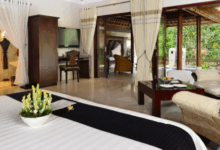Affordable Luxury Hotels In Australia
Australia, a land of stunning landscapes and vibrant cities, offers a unique blend of luxury and affordability in its hotel sector. This guide delves into the fascinating world of “affordable luxury” hotels across the country, exploring what defines this niche market, its geographic distribution, the amenities offered, and the target audience it caters to. We’ll examine the competitive landscape, pricing strategies, guest experiences, and future trends shaping this dynamic segment of the Australian hospitality industry.
From the bustling metropolises of Sydney and Melbourne to the sun-kissed shores of Queensland and the rugged beauty of Western Australia, we will uncover hidden gems and established brands that provide a luxurious experience without breaking the bank. We’ll consider the factors that contribute to the perception of luxury in Australia, comparing it to international standards and highlighting the unique characteristics of the Australian market.
This exploration aims to provide a comprehensive understanding of the affordable luxury hotel sector in Australia, assisting both potential travelers and industry professionals alike.
Defining “Affordable Luxury” in the Australian Context
Defining “affordable luxury” in the Australian hotel market requires a nuanced understanding of price points, amenities, and the expectations of different target audiences across various cities. It’s a concept that shifts based on location, seasonality, and the specific hotel’s offerings. While a universally accepted definition is elusive, we can examine the factors contributing to its perception.
The concept of affordable luxury in Australian hotels is inherently tied to the cost of living in each city. What constitutes affordable luxury in Brisbane, with its generally lower cost of living compared to Sydney, will differ significantly. In Sydney, for example, an “affordable luxury” hotel might be priced between $250-$500 AUD per night, offering amenities such as a stylishly designed room, a well-equipped gym, and perhaps a rooftop pool or bar.
In contrast, a similar level of luxury in Brisbane could be achieved for $150-$350 AUD per night, reflecting the difference in market rates. Melbourne, Perth, and Adelaide would fall somewhere in between these two extremes, each with its own specific price range and associated amenities reflecting the local market.
Price Points and Amenities Across Australian Cities
The price range considered “affordable luxury” varies considerably across Australia’s major cities. This variance is primarily driven by factors like location, proximity to key attractions, and the level of service offered. For instance, a boutique hotel in a prime location in Sydney’s CBD might command higher prices than a similarly appointed hotel in a slightly less central area, or a larger hotel chain offering similar amenities at a slightly lower price point.
Similarly, a hotel with exceptional views, a renowned restaurant, or a highly rated spa will naturally command a higher price, even if the core room amenities are comparable to more budget-friendly options.
Comparison with International Standards of Affordable Luxury
Comparing Australia’s “affordable luxury” hotel market to other countries requires considering the overall cost of living and prevailing standards of luxury. In cities like London or New York, the price point for “affordable luxury” would be significantly higher than in Australian cities. This reflects the higher cost of land, labour, and general living expenses in these international hubs. Conversely, in some Southeast Asian countries, the same level of amenities could be achieved at a much lower price.
The definition of “affordable luxury” is therefore always relative to the local economic context and the expectations of the target market.
Factors Influencing the Perception of Luxury in the Australian Hotel Market
Several factors influence how luxury is perceived in the Australian hotel market. These include the increasing demand for sustainable and eco-friendly practices, a growing preference for locally sourced products and experiences, and a strong emphasis on wellness and wellbeing. Australian travellers increasingly value unique and authentic experiences, seeking hotels that reflect the local culture and environment. This translates into a demand for hotels that incorporate local art, design, and produce, and that offer opportunities for engaging with the surrounding community.
Furthermore, the increasing awareness of environmental concerns means that sustainable practices, such as water conservation and waste reduction, are becoming important factors in determining the perceived luxury of a hotel.
Geographic Distribution of Affordable Luxury Hotels
Australia’s diverse landscape and varied tourism hotspots influence the distribution of affordable luxury hotels. These establishments are strategically located to cater to both domestic and international travellers seeking a balance between comfort, style, and value. Factors such as proximity to attractions, accessibility, and local market demand significantly impact their geographic spread.
The concentration of affordable luxury hotels varies considerably across Australia. Major cities like Sydney, Melbourne, Brisbane, and Perth naturally boast a higher density due to increased tourism and business travel. Coastal regions, particularly those popular for their beaches and natural beauty, also tend to have a significant presence. Conversely, remote or less-populated areas may have fewer options, although boutique hotels offering a unique, luxury experience might still exist in these locations.
Geographic Distribution Map
Imagine a map of Australia. The eastern coast, from Sydney to Cairns, shows a high density of markers representing affordable luxury hotels. A cluster of markers is concentrated in Sydney and Melbourne, reflecting their status as major metropolitan hubs. Brisbane and Perth also show a significant number of markers, albeit fewer than Sydney and Melbourne. The coastal regions of Queensland and New South Wales are relatively densely marked, reflecting the popularity of beachside tourism.
Sparsely populated areas in the Outback and the Northern Territory show fewer markers, indicating a lower concentration of these hotels. The southern coast also exhibits a moderate density, especially around Adelaide and Tasmania.
Examples of Affordable Luxury Hotels Across Australia
The following table provides examples of affordable luxury hotels in various Australian locations, showcasing the diversity of offerings and price points.
| City | Hotel Name | Price Range (AUD per night) | Key Features |
|---|---|---|---|
| Sydney | (Example Hotel Name – Replace with actual hotel) | $250 – $450 | Harbour views, rooftop pool, stylish rooms |
| Melbourne | (Example Hotel Name – Replace with actual hotel) | $200 – $350 | Laneway location, boutique design, excellent restaurants |
| Brisbane | (Example Hotel Name – Replace with actual hotel) | $180 – $300 | River views, modern amenities, close to city centre |
| Perth | (Example Hotel Name – Replace with actual hotel) | $220 – $400 | Oceanfront location, spa facilities, luxurious rooms |
| Cairns | (Example Hotel Name – Replace with actual hotel) | $150 – $280 | Tropical gardens, proximity to Great Barrier Reef tours, relaxed atmosphere |
| Adelaide | (Example Hotel Name – Replace with actual hotel) | $170 – $320 | City centre location, historic building, elegant design |
Geographic Location and Pricing Strategies
The pricing strategies of affordable luxury hotels are intrinsically linked to their geographic location. Hotels in major capital cities, particularly those with prime locations and exceptional views, command higher prices due to increased demand and operational costs. Coastal resorts in popular tourist destinations also tend to have higher rates, especially during peak seasons. Conversely, hotels in smaller cities or regional areas may offer lower prices, reflecting reduced demand and potentially lower operating expenses.
However, even in these locations, unique offerings and high-quality services can justify premium pricing, reflecting the concept of “affordable luxury” within a specific context. For example, a boutique hotel in a remote area offering exceptional seclusion and personalized service might command a higher price despite its location.
Hotel Amenities and Services
Affordable luxury hotels in Australia strive to provide a premium experience without the exorbitant price tag of five-star establishments. This is achieved through a careful selection of amenities and services that deliver high quality and comfort, focusing on key areas that enhance the guest’s overall stay. The balance between value and luxury is crucial, and this is reflected in the offerings provided.The amenities and services offered by affordable luxury hotels in Australia vary depending on the specific property, brand, and location.
Larger hotel chains often offer a standardized range of amenities across their properties, ensuring a consistent experience for their guests. Independent hotels, on the other hand, may showcase more unique or locally-inspired offerings, reflecting the individual character of the hotel and its surroundings. This often results in a more bespoke and personalized experience. The key differentiator, however, lies in the quality and presentation of these services, ensuring they meet the expectations of discerning travellers seeking a luxurious yet accessible experience.
Essential Amenities and Services Contributing to a Luxurious Experience
Affordable luxury hotels in Australia typically offer a range of essential amenities that contribute to a luxurious experience. These include comfortable and well-appointed rooms with high-quality bedding and linens, modern bathrooms with premium toiletries, and reliable high-speed internet access. Many also feature inviting communal spaces such as stylish lounges or rooftop bars, offering opportunities for relaxation and socializing. A consistently high level of customer service is also paramount, with staff trained to provide personalized attention and anticipate guest needs.
Finally, many affordable luxury hotels offer enhanced breakfast options, moving beyond a simple continental spread to include a wider selection of fresh, local produce and gourmet options.
Comparison of Amenities Offered by Different Hotel Chains and Independent Properties
Comparing the amenities offered by different hotel chains and independent properties reveals distinct approaches to affordable luxury. Larger chains, such as QT Hotels & Resorts or Ovolo Hotels, often prioritize stylish design and contemporary amenities, such as well-equipped gyms and stylish swimming pools. They typically offer a consistent experience across their various locations. In contrast, independent boutique hotels might focus on unique local experiences, such as partnering with nearby restaurants for exclusive dining experiences or offering curated tours and activities highlighting the surrounding area.
For example, a boutique hotel in the Yarra Valley might offer wine tasting experiences at local vineyards, while a hotel in the Blue Mountains could provide guided hikes through the national park. The key difference often lies in the level of personalization and the emphasis on local character versus a standardized, branded experience.
Unique Amenities and Services Differentiating Affordable Luxury Hotels in Australia
The following amenities and services distinguish affordable luxury hotels in Australia and contribute to their unique appeal:
- Locally Sourced Amenities and Food: Many hotels utilize locally sourced ingredients in their restaurants and bars, and provide locally made toiletries in the rooms, supporting local businesses and offering a unique taste of the region.
- Experiential Packages: Some hotels offer curated packages that include unique experiences such as private wine tastings, cooking classes, or guided tours, enhancing the overall travel experience beyond just accommodation.
- Personalized Service: A commitment to personalized service, often extending beyond the typical hotel concierge services, creates a more intimate and luxurious feel. This might include tailored recommendations based on guest preferences or special in-room amenities upon arrival.
- Sustainable Practices: Increasingly, affordable luxury hotels are incorporating sustainable practices, such as using eco-friendly products and minimizing their environmental impact. This resonates with environmentally conscious travelers seeking a luxurious and responsible travel experience.
- Pet-Friendly Options: While not universal, some affordable luxury hotels are becoming more pet-friendly, offering comfortable accommodations and amenities for guests travelling with their furry companions, adding a unique touch of convenience and comfort.
Target Audience and Marketing Strategies
Understanding the target audience for affordable luxury hotels in Australia is crucial for effective marketing. This demographic is characterized by a desire for high-quality experiences and amenities without the exorbitant price tag associated with ultra-luxury accommodations. They are discerning travelers who value both comfort and value, seeking unique and memorable experiences within their budget.The typical guest seeking affordable luxury hotels in Australia is likely to be a millennial or Gen X traveler, often couples or small groups, with a higher disposable income than the average traveler but still conscious of spending.
They are digitally savvy, researching extensively online before booking, and actively seeking authentic and local experiences. Family travelers with children also represent a significant segment, prioritizing family-friendly amenities and convenient locations. Business travelers may also fall into this category, looking for comfortable and well-appointed accommodations without the premium price of top-tier business hotels.
Successful Marketing Strategies
Australian hotels successfully attract this target audience through a variety of strategies emphasizing value and unique experiences. Many hotels leverage partnerships with local businesses, offering curated packages that combine accommodation with activities such as wine tours, cooking classes, or guided hikes. This approach provides guests with a more immersive and memorable experience beyond simply staying in a hotel.
Highlighting the hotel’s unique character and local connections is also key. This could involve showcasing the hotel’s sustainable practices, highlighting locally sourced food and beverages in their restaurants, or partnering with local artisans to offer unique in-room amenities. For example, a hotel might partner with a local winery to offer complimentary wine tasting upon arrival, or collaborate with an indigenous artist to feature their work within the hotel.
Online Platforms and Social Media Marketing
Online platforms and social media play a vital role in promoting affordable luxury hotels in Australia. High-quality photography and videography showcasing the hotel’s amenities, location, and overall atmosphere are essential. Utilizing platforms like Instagram, Facebook, and TikTok allows hotels to target specific demographics with tailored advertising campaigns. User-generated content, such as guest reviews and photos shared on social media, is highly influential in shaping potential guests’ perceptions.
Hotels actively encourage this by running contests or offering incentives for guests to share their experiences online. Strategic partnerships with travel bloggers and influencers can also significantly enhance brand awareness and reach a wider audience. Effective search engine optimization () is crucial for ensuring the hotel’s website ranks highly in search results for relevant s, such as “affordable luxury hotels in Sydney” or “boutique hotels in Melbourne.” Paid advertising campaigns on Google and other search engines can further increase visibility and drive bookings.
Competitive Landscape and Pricing Strategies
The Australian affordable luxury hotel market is a dynamic and competitive landscape, shaped by a diverse range of established international brands, boutique operators, and independent hotels. Competition is fierce, particularly in popular tourist destinations, requiring careful consideration of pricing strategies to attract and retain guests. Understanding the competitive dynamics and implementing effective pricing models are crucial for success in this segment.The competitive landscape is characterized by a mix of established international brands offering consistent quality and recognition, and smaller, independent hotels that leverage unique local experiences and personalized service to differentiate themselves.
The presence of both large chains and smaller boutique hotels creates a wide range of options for consumers seeking affordable luxury. This necessitates a sophisticated approach to pricing that considers not only operational costs but also the perceived value proposition offered by each hotel.
Pricing Strategies in the Affordable Luxury Segment
Affordable luxury hotels in Australia employ a variety of pricing strategies, often adapting them based on seasonal demand and market conditions. Dynamic pricing, where rates fluctuate based on real-time demand, is becoming increasingly common. This allows hotels to maximize revenue during peak seasons and offer more competitive rates during slower periods. Many hotels also utilize tiered pricing, offering different room types and packages at varying price points to cater to a wider range of budgets and preferences.
Promotional offers, such as early bird discounts or last-minute deals, are also frequently used to stimulate demand and fill vacancies. The pricing strategy often reflects the hotel’s overall brand positioning – a boutique hotel might command a premium price due to its unique character and personalized service, while a larger chain might prioritize competitive pricing to attract a broader customer base.
Factors Influencing Pricing Decisions
Several key factors influence the pricing decisions of affordable luxury hotels in Australia. These include operational costs (staffing, utilities, maintenance), location (city center hotels typically command higher rates than those in suburban areas), seasonality (peak tourist seasons result in higher prices), competition (prices are often adjusted based on competitor rates), and perceived value (unique amenities, service levels, and brand reputation impact pricing).
The overall economic climate and consumer spending habits also play a significant role. For instance, during periods of economic uncertainty, hotels might adjust their pricing strategies to remain competitive and attract budget-conscious travellers while maintaining a perceived level of luxury. Furthermore, the availability of alternative accommodation options, such as Airbnb, also influences pricing decisions. Hotels might need to offer competitive rates to attract guests who are considering these alternative options.
Examples of Pricing Strategies
Consider two hypothetical hotels: Hotel A, a large international chain located in Sydney’s CBD, might use a dynamic pricing model heavily influenced by competitor rates and real-time demand, offering discounts during the off-season and premium pricing during peak periods like New Year’s Eve. In contrast, Hotel B, a small boutique hotel in the Yarra Valley wine region, might maintain a relatively stable price throughout the year, relying on its unique location and personalized service to justify its premium pricing, perhaps offering packages that include wine tasting experiences.
Both strategies are viable within the affordable luxury segment, demonstrating the diverse approaches used to balance revenue generation with attracting guests.
Guest Experience and Reviews
Guest reviews are crucial for affordable luxury hotels in Australia, shaping their reputation and influencing future bookings. Positive reviews highlight exceptional service and amenities, attracting potential guests, while negative reviews offer valuable insights for improvement. Analyzing both positive and negative feedback provides a comprehensive understanding of the guest experience and allows hotels to maintain high standards.Positive guest reviews frequently focus on the balance between luxurious amenities and affordable pricing.
This balance is a defining characteristic of the “affordable luxury” segment. Guests appreciate the attention to detail and the overall experience that exceeds expectations given the price point.
Positive Guest Review Examples
Many positive reviews emphasize the personalized service, highlighting the staff’s attentiveness and willingness to go the extra mile. For instance, a review might praise the staff’s prompt response to a request for extra pillows or their helpful recommendations for local restaurants. Other positive comments often focus on the cleanliness and comfort of the rooms, describing them as stylish, well-maintained, and equipped with high-quality amenities such as comfortable beds, luxurious linens, and well-stocked bathrooms.
Reviews also frequently mention the hotel’s location, highlighting its proximity to key attractions or its peaceful and tranquil setting. A typical example might read: “The hotel exceeded our expectations! The room was beautifully decorated and spotlessly clean, and the staff were incredibly friendly and helpful. The location was perfect for exploring the city.”
Key Elements Contributing to a Positive Guest Experience
Several key elements consistently contribute to a positive guest experience in affordable luxury hotels. These include: high-quality accommodation with stylish design and comfortable furnishings; impeccable cleanliness and maintenance; friendly, attentive, and efficient staff; convenient location with easy access to attractions and transportation; and a range of amenities that enhance the guest’s stay, such as complimentary Wi-Fi, a well-equipped fitness center, or a delightful breakfast.
The overall atmosphere should also be considered, encompassing a sense of calm, sophistication, and welcoming hospitality. The seamless integration of technology, such as user-friendly online booking systems and efficient check-in processes, also contributes significantly to a positive experience.
Addressing Negative Feedback and Maintaining Service Standards
Addressing negative feedback is vital for maintaining a high standard of service. Hotels should promptly respond to negative reviews, acknowledging the guest’s concerns and offering sincere apologies for any shortcomings. They should then actively work to resolve the issue and prevent similar problems from occurring in the future. This often involves implementing changes to procedures, staff training, or facilities.
For example, if a guest complains about noise levels, the hotel might implement better soundproofing measures or relocate the guest to a quieter room. Proactive monitoring of online reviews allows for the identification of recurring issues, enabling hotels to make necessary improvements and maintain consistent high standards of service and guest satisfaction. This proactive approach helps build trust and strengthens the hotel’s reputation, ultimately leading to improved customer loyalty and increased bookings.
Future Trends in Affordable Luxury Hotels
The Australian affordable luxury hotel sector is poised for significant evolution, driven by shifting consumer priorities and technological advancements. This section will explore emerging trends, focusing on sustainability, technological integration, and the adaptation strategies necessary for continued success in this dynamic market. We will also examine the likely impact of these changes on the guest experience and the overall market landscape.
Several key trends are shaping the future of affordable luxury hotels in Australia. A growing emphasis on sustainability is influencing design, operations, and guest experiences. Simultaneously, technological innovations are transforming how hotels operate and interact with their guests. These advancements, combined with evolving consumer preferences, require hotels to adopt innovative strategies to maintain competitiveness and appeal to a discerning clientele.
Sustainable Practices in Affordable Luxury Hotels
The increasing awareness of environmental concerns is driving a strong demand for eco-conscious travel. Affordable luxury hotels are responding by incorporating sustainable practices throughout their operations. This includes the adoption of energy-efficient technologies, sourcing locally produced food and amenities, implementing water conservation measures, and reducing waste through recycling and composting programs. For example, several boutique hotels in regional areas of Australia are showcasing their commitment to sustainability by partnering with local farmers and artisans, offering guests unique experiences alongside eco-friendly accommodations.
This approach not only reduces their environmental impact but also enhances the local character and appeal of the hotel. The integration of solar panels, rainwater harvesting systems, and the use of recycled materials in construction are also becoming increasingly common.
Technological Advancements and Guest Experience Enhancement
Technological integration is revolutionizing the guest experience in affordable luxury hotels. Mobile check-in/check-out, keyless entry systems, and personalized in-room entertainment are becoming standard features. Furthermore, the use of AI-powered chatbots for guest services and automated room service delivery systems is streamlining operations and enhancing efficiency. The adoption of smart room technology, allowing guests to control lighting, temperature, and entertainment systems through their smartphones, offers a seamless and personalized stay.
Hotels are also leveraging data analytics to understand guest preferences better, enabling them to tailor their services and offerings for a more customized and memorable experience. For instance, a hotel might use data to anticipate a guest’s needs, such as providing a preferred type of coffee or arranging a specific amenity based on their past stays.
Adapting to Changing Consumer Preferences
Consumer preferences are evolving rapidly, demanding a more personalized, authentic, and experiential travel approach. Affordable luxury hotels are adapting by offering unique experiences that go beyond traditional accommodation. This includes curated local experiences, such as guided nature walks, cooking classes, or wine tasting tours. They are also focusing on creating a sense of community and connection with the local area, highlighting local art, culture, and cuisine.
The rise of wellness tourism is also influencing the market, with hotels incorporating wellness facilities like yoga studios, spas, and healthy dining options to cater to this growing demand. Furthermore, flexible booking options and personalized service are becoming increasingly crucial in meeting the expectations of today’s travellers. For example, a hotel might offer customizable packages allowing guests to tailor their stay according to their preferences, such as choosing specific activities or dining experiences.
Ending Remarks
In conclusion, the Australian affordable luxury hotel market presents a dynamic and exciting segment within the broader hospitality industry. By understanding the key factors influencing pricing, amenities, target audiences, and future trends, both travelers and businesses can navigate this landscape effectively. The pursuit of affordable luxury in Australia offers a unique opportunity to experience the country’s diverse offerings while enjoying a high level of comfort and service.
Whether seeking a romantic getaway, a family vacation, or a business trip, the options are diverse and cater to a wide range of preferences and budgets. The continued evolution of this market promises an even wider selection of exceptional experiences in the years to come.
FAQ Insights
What constitutes a “luxury” experience in an affordable luxury hotel in Australia?
This typically includes high-quality bedding, modern amenities (e.g., high-speed Wi-Fi, flat-screen TVs), stylish design, excellent service, and often, access to additional features like pools, gyms, or on-site restaurants, depending on the specific hotel and location.
Are there significant price differences between affordable luxury hotels in different Australian cities?
Yes, prices vary considerably depending on location, season, and hotel amenities. Major cities like Sydney and Melbourne tend to have higher prices than smaller cities or regional areas.
How can I find the best deals on affordable luxury hotels in Australia?
Booking in advance, traveling during the off-season, utilizing hotel loyalty programs, and comparing prices across different booking websites are effective strategies for securing the best deals.
What are some unique amenities offered by Australian affordable luxury hotels?
Some hotels may offer unique experiences reflecting the local culture, such as Aboriginal art displays, guided nature walks, or access to local wineries or breweries.
What types of payment methods are typically accepted?
Most hotels accept major credit cards (Visa, Mastercard, American Express), debit cards, and sometimes even digital payment platforms like Apple Pay or Google Pay. It’s always best to check directly with the hotel to confirm their accepted payment methods.









